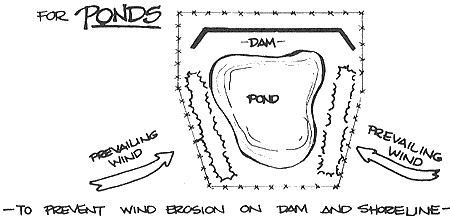Windbreaks are rows of trees and shrubs that protect areas from wind. Windbreaks have many benefits, including improving wildlife habitat, reducing heating bills, providing protection from high winds and snow, and enhancing landscape aesthetics.
USDA NRCS
How big should my windbreak be?
Where space permits, a windbreak of five rows of trees and shrubs is recommended. A five-row windbreak with proper spacing between rows will measure from 80 to 90 feet in width. If space is limited, you can plant three rows, measuring from 40 to 50 feet in width, for a similar affect.
What kinds of trees and shrubs should I use?
Hardwood and deciduous trees, which shed their leaves in the fall, are not as effective as evergreen species for winter protection. However, the bare limbs of deciduous trees will reduce wind velocities to some extent. Also, hardwood species are faster growing and taller at maturity than most evergreens. A combination of evergreens and hardwoods is recommended for optimal performance in the shortest amount of time.
When should I plant?
You should start planning the windbreaks in the fall and plant in the spring. Use the diagrams below to help you plan an effective windbreak.

Row 1/Row5
- Black haw
- Deciduous holly
- Flowering quince
- Forsythia
- Highbush cranberry
- Lilac
- Mock orange
- Redbud
- Pyracantha
- Privet
- Nanking cherry
Row 2/Row 4
- Black alder
- Hawthorn
- Jack pine
- Persimmon
- Red cedar
- Scotch pine
- Serviceberry
- Norway spruce
Row 3
- Pin oak
- Northern red oak
- Shingle oak
- Soft maple
- White pine
- Loblolly pine
- Shortleaf pine
- Yellow Poplar
Planting Plan
The diagram below shows the planting arrangement of a hardwood and evergreen windbreak. The staggered row arrangement gives best coverage.
Rows one through three can be used when creating a three-row windbreak with row one on the windward side (side exposed to the wind).
To be effective, a three-row windbreak should have its middle row at least 100 feet from any building or roads needing protection from winds and drifting snow. When planning the shape of windbreak, consider wind direction, roads, topography, buildings, fences, available space, and other trees present.
Tips for Windbreaks
- Mark where you will be planting at your windbreak site before the trees and shrubs arrive.
- Planting should begin as soon as possible. If a delay is necessary, store seedlings in a cool place in the shade.
- It is very important to keep the roots moist until planting, but do not submerge the roots in standing water.
- Plant trees in small numbers using a tree-planting bar or tile spade. A power post hole auger is an ideal way of planting larger seedlings.
- Seedling loss will occur during the first year when the seedlings are just beginning to develop. The roots require thorough watering on a weekly basis during the first growing season, especially in the hot summer months.
- Any attempt to establish a windbreak without weed control is likely to be disastrous. Weeds can be controlled by cultivation or mulching. Immediately after planting, trees need to be staked to provide protection from lawn mowers, especially in those areas where weed control may be delayed.
- Fertilizer should not be applied for a year or two to avoid competition from grass and weeds. Excessive applications of fertilizer can damage young roots.



































